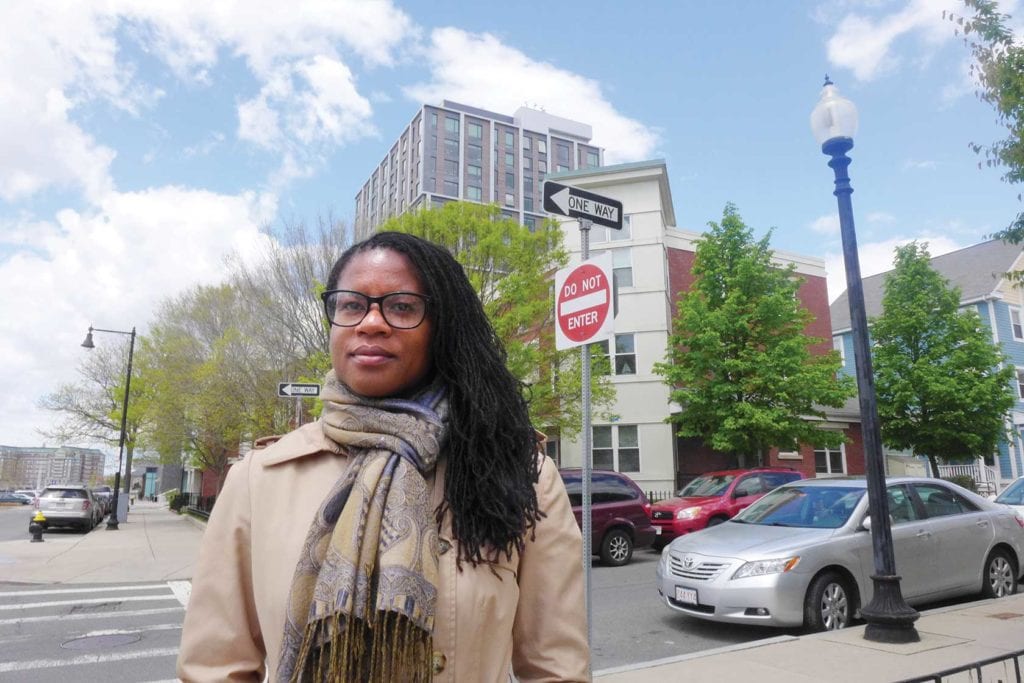New East Boston homes out of reach for residents
Evictions on rise as luxury units flood neighborhood

Walking through the Jeffries Point section of East Boston recently, City Councilor Lydia Edwards pointed to different housing developments to underscore the growing inequality in her neighborhood.
On one side of Summer Street, Maverick Landing, a 396-unit, $120 million mixed-income Boston Housing Authority development is an example of what Edwards believes the city ought to be aiming for in East Boston.
“This is how you develop housing,” she said. “Breaking down barriers of poverty.”
But just across the street, The Mark, a six-to-nine-story luxury building currently under development, is marketing its luxury units with the tagline: “Welcome to East Boston’s new vantage point.”
Like much of the new development in the neighborhoods, The Mark will literally cancel out much of old East Boston’s vantage point, blocking Maverick Landing residents and others from their view of the waterfront and downtown Boston.
To the west, the 16-story Eddy Apartments — which opened in 2016 as the neighborhood’s first luxury tower — now dominates the skyline.
Many longtime East Boston residents fear that the new developments, rather than bring opportunities for residents of the predominantly Latino and Italian neighborhood, will instead bring displacement.
“We’ve known displacement was coming since we saw development come to the waterfront in 2013,” said Gloribel Mota, who grew up in the neighborhood and is executive director of Neighbors United for a Better East Boston. “The concern is, are we creating housing for the people who live here, or the people who are moving us out?”
At The Eddy, the rent for studio apartments starts at $2,000. At Boston East, a 499-square-foot one-bedroom apartment is listed at $2,306. Clippership Apartments on the Wharf lists studio units at prices from $2,339 to $2,619.
Locals under pressure
Amid a construction boom dominated by studio and one-bedroom apartments, Edwards points out that the average household currently in East Boston has 2.66 people. The new developments, Edwards said, aren’t aimed at the people currently living there.
“They don’t reflect the needs of the neighborhood,” she said. “They reflect the needs of folks who don’t live here yet.”
Meanwhile, tenants in the neighborhood’s multifamily apartment buildings are facing evictions and building clear-outs as longtime owners sell to developers ready to convert the units into luxury dwellings.
The Jamaica Plain-based City Life/Vida Urbana group holds weekly meetings in East Boston, where tenants facing rent increases and evictions can seek counseling and help. The Wednesday meetings draw dozens.
“There are a lot of building clear-outs,” said Steve Meacham, City Life/Vida Urbana’s organizing coordinator. “A whole lot of speculators buying three-to-six-unit buildings. Rents jump from $1,000 to $2,000. Of course, it’s strongly influenced by all the luxury developments going up.”
While there are no reliable statistics on how many people are being displaced from East Boston, Edwards points to declining enrollment at East Boston schools, which have lost more than $1 million under the school department’s weighted student funding formula as families have moved to lower-rent areas in Everett and Revere.
Another metric for displacement is the number of eviction cases in housing court.
“You can look in East Boston Court and see how many people are being evicted,” Edwards notes.
But even the court figures are not a solid metric, as many tenants voluntarily move out when landlords double their rents or give up on the time-consuming court process.
“Evictions aren’t recorded if they don’t get to court,” Meacham said.
City Life/Vida Urbana is working in coalition with groups including Neighbors United for a Better East Boston, the Center for Cooperative Development and Solidarity, Stand For Democracy, Cosecha and the Chelsea-based GreenRoots to strategize on ways to help residents remain in their neighborhoods.
“We are in a crisis,” Edwards said. “People are worried about making rent. It’s not just extremely poor people. You hear it from people who have good jobs.”
Suffolk Downs development
A planned 10,000-unit housing development at the site of the Suffolk Downs racetrack could put further pressure on the market. With the developer, HYM Investment Group, calling for 1.5 people per unit, current East Boston households won’t likely be a target demographic for the new housing.
The Boston Planning and Development Agency has launched a PLAN: East Boston process to give local residents and business owners an opportunity to weigh in on zoning changes that could guide development in the neighborhood.
Edwards says the BPDA planning process, while late to the game, is a welcome development. She says the city and East Boston residents should be determining what is built in the neighborhood, not developers.
“We need to look at the diversity of this neighborhood and plan accordingly,” she said. “We need to work with developers to figure out what incentives they need to meet the needs of the people living here.”
If the planning process puts current residents at its center, it could go a long way toward combatting displacement, according to Edwards.
“If you can plan for a single mother who is struggling, you can plan for everyone else,” she said. “Everybody else will be just fine.”
An alienated native
In Maverick Square, Edwards stopped to chat with a cab driver named Tony, who is a lifelong neighborhood resident. Tony, who did not want his last name used for this story, complained that the new six-story luxury apartment buildings took away his view of the ocean and downtown Boston. More than that, he is unhappy about his new neighbors — he refers to them as “yuppies” — who barely acknowledge him.
“At one time, I knew everyone in East Boston,” he said. “Now I’m a stranger on my own block.”








